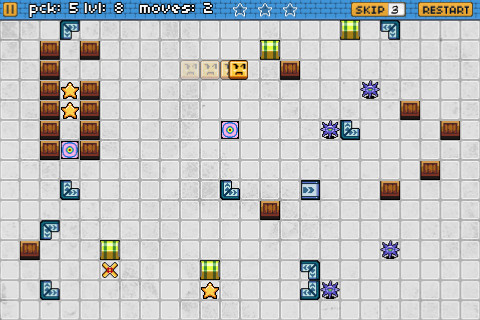In this sequence of tutorial pages we will be creating a game similar to the Blocks Mania iOS game.
Game Introduction (VIDEO)
The game consists of a tiled game board like the one shown below:

We will begin with a very simple game board that consists of blank tiles ( / ), the player (
/ ), the player ( / @), and the end point (
/ @), and the end point ( / X):
/ X):
0123456789 0 1 X @ 2 3 4
Tile and Position Classes (VIDEO)
We will represent each spot on the gameboard with a tile. Each tile is a button that can be pressed by clicking with the mouse. Each tile keeps track of a position (column and row) and a type. What follows is a first attempt at these classes.
public class Position {
public final int col;
public final int row;
public Position(int col, int row) {
this.col = col;
this.row = row;
}
}
Since the Position class just describes the pairing of integers, I've made the attributes public. Note also that I've declared the attributes as final.
public class Tile extends JButton {
private final Position position;
private final char type;
public Tile(Position position) {
this(position, ' ');
}
public Tile(Position position, char type) {
super("" + type);
this.position = position;
this.type = type;
}
}
The type attribute is used to distinguish between different types of game tiles. In the beginning stages of our development, this type will just be a character that will be displayed as the label for the button.
QUESTIONS/EXERCISES
- What are the advantages of declaring the
Positionattributes aspublic? - What are the disadvantages of declaring the
Positionattributes aspublic? - Since the type will be the same for every object from the
Tileclass, can you think of a better way to store this information?
Game Movement (VIDEO)
The video describes the intended behavior when the player makes a move. If the tile at row: 1, col: 3 is clicked, the tile at row: 1, col: 8 should determine what should happen next. If this tile is a blank tile, then the Player should be moved to position row: 1, col: 8, and the next move should be moved based on the tile at position row: 1, col: 7.
0123456789 0 1 X @ 2 3 4
Therefore, we add the following method to the Tile class:
public class Tile extends JButton {
// ...
public Move processMove(Move move) {
return move;
}
}
The Move class keeps track of the current position and direction that the Player is moving. The direction is defined as one of a number of class constants:
public class Move {
public final static int DIRECTION_NORTH = 0;
public final static int DIRECTION_SOUTH = 1;
public final static int DIRECTION_WEST = 2;
public final static int DIRECTION_EAST = 3;
public final static int DIRECTION_STOP = 4;
public final static int DIRECTION_WIN = 5;
public final static int DIRECTION_LOSE = 6;
private final int direction;
private final Position position;
public Move(int direction, Position position) {
this.direction = direction;
this.position = position;
}
public int getDirection() {
return direction;
}
public Position getPosition() {
return position;
}
}
QUESTIONS/EXERCISES
- Which class constant directions are not required to implement the
Tile.processMove()method? - Implement the
processMove()method for theTileclass that represents a blank tile. - The
positionanddirectionattributes are declaredfinal. What implications does this have on how objects from theMoveclass can be used?
Gameboard Class (VIDEO)
A GameBoard class is used to manage the GUI of each level of the game. The GameBoard is a JPanel that contains a grid of buttons.
public class GameBoard extends JPanel {
private Tile[][] gameboard;
public GameBoard(String filename) {
loadGame(filename);
createGUI();
}
private void createGUI() {
// Use GridLayout
// Add tiles to JPanel
}
private void loadLevel(String filename) {
// Read in characters from file
// Allocate space for gameboard 2D array
// Create tiles from characters
// Add tiles to gameboard
// Connect action listener to each tile
}
}
QUESTIONS/EXERCISES
- Implement the
loadLevel()method for theGameBoardclass. - Implement the
createGUI()method for theGameBoardclass.
Game and WinTile Classes (VIDEO)
For now, the Game class will just create a game using the first level of the game. Eventually it will need to manage multiple levels and the transition between levels.
public class Game extends JFrame {
public static void main(String[] ignored) {
JFrame game = new Game();
game.setVisible(true);
}
public Game() {
super("Maniacal Blocks");
this.setSize(300, 200);
this.setDefaultCloseOperation(EXIT_ON_CLOSE);
add(new GameBoard("levels/level1.txt"));
}
}
public class WinTile extends Tile {
public WinTile(Position position) {
super(position, 'X');
}
@Override
public Move processMove(Move move) {
return move;
}
}
QUESTIONS/EXERCISES
- The
EndTileclass in the video has been renamedWinTilehere. Why? - Implement the
processMove()method for theWinTileclass. - Modify the
Gameclass to add a panel that shows the number of moves made and contains a RESTART button.
Last modified: Monday, 29-Jul-2024 06:54:47 EDT